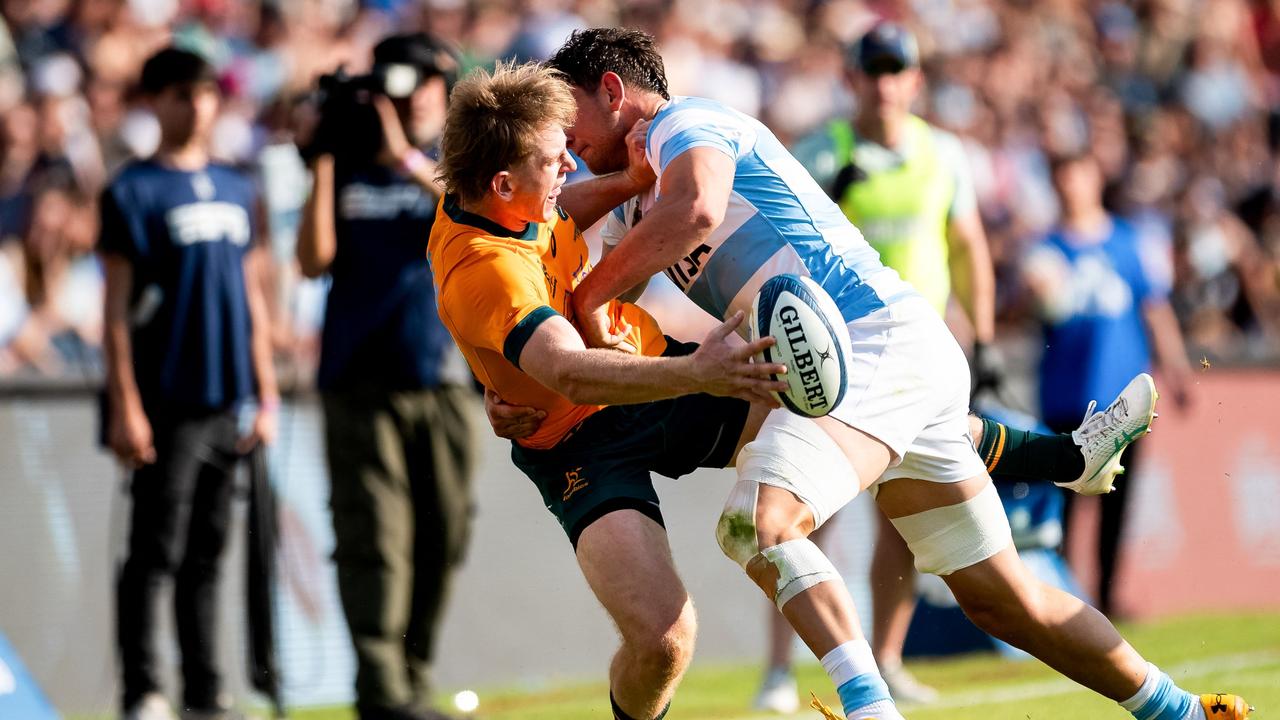Mark Gasnier signs Rugby Australia deal to make Tri Tag official touch version of game
Struggling behind the NRL and AFL for junior participation, rugby has found an unlikely ally in a league legend.

Rugby
Don't miss out on the headlines from Rugby. Followed categories will be added to My News.
RUGBY has a new secret weapon to lure the next generation of talent away from the NRL – league’s very own Mark Gasnier.
The former State of Origin star and NRL premiership winner has signed a contract with Rugby Australia to make his non-contact version of union, Tri Tag, the official sport used in schools and clubs across the country to attract children to rugby.
It is a major coup for rugby, which has struggled against the behemoth codes of NRL and AFL to attract the best young talent over the past two decades.
Gasnier, the nephew of rugby league Immortal Reg Gasnier, is happy to play his part in lifting participation rates in union having spent the last two years of his professional career playing rugby in France.

“I love the banter when I go around to the all the rugby clubs, ‘What’s this bloody leaguie doing here?’ which is fair enough with my family history,” Gasnier told this masthead.
“I played league all my life. I played two years of rugby in France. I get that.
“But rugby league is lucky, they have Oz Tag and touch footy, these non-contact formats in front of their face. Without disrespecting previous formats, in my opinion there was never a non-contact rugby game that taught a player the skill-set and knowledge required where they could jump straight over to the contact.
“So that’s where it has all come from.
“And I always through the future of contact was always complemented by a non-contact version, it’s just the way the world is going.
“But I don’t want this game to be its own sport. Oz Tag and touch football have a presence where they are their own sport, this game is purely here to complement the core products of rugby; the Sevens and the XVs.
“People should understand this is not, ‘Hey let’s call it the Mark Gasnier Tri Tag’ and he wants to have his own sport. I couldn’t care less. It’s purely about giving kids an opportunity and if and when they want, they can transition to the contact.”

But Gasnier also has a global vision for Tri Tag, a sport he has spent the past two years creating and finetuning.
“It was always the play to go global, but you’ve got to get approval and support,” Gasnier said. “And Australia is a great market to test that, because it is a very tough market.
“We have rugby league, AFL, Oz Tag, tough football. And it’s a smaller population.
“I made no secret when I said to RA I would roll it for them, I said that the ultimate goal is to try to make it as global as possible.
“If you look at it from a business perspective, rugby is big around the world.
“Australia is saturated with rugby league formats. It’s not about alliances, it’s about giving kids an opportunity in that space to stay within the game.
“Yes, league gave me so much, gave me a lot of my life.
“You want to keep kids in sport as much as possible, and technology is not going anywhere. We’re never going to get kids off tech, we just need to find that balance.”
Unlike Oz Tag and touch footy, Tri Tag requires rugby-specific techniques that replicate the contact version of the game, including “cleaning out” a breakdown.
Two side tags are connected to the uniforms, while one at the back can be removed like in Oz Tag, but with an attacking player needing to support the ballrunner by removing the back tag within five seconds of a touch to indicate securing the breakdown. If a support player does not remove the back tag in five seconds, it is deemed a pilfer turnover, and the defending team takes the ball.
There are various versions of the game; it can be played five-on-five, with limited lineout and scrum options on half a football field for children aged six, through to the full version which is 10 versus 10, with five-person scrums and lineouts across a full field and including goalkicking.

“It would be great to see the Wallabies and Kangaroos battle each other in this format, because it is a great hybrid,” Gasnier said.
“You’re three metres back, if you kick the ball out on the full it’s a penalty from where you kicked the ball, so it keeps ball in play.
“What people like about it is that it’s not as fast as touch football, you don’t have to go 10 metres back like Oz Tag.
“You get seven phases to score a try and you can kick on any play.”
Gasnier is hopeful Tri Tag can reinvigorate union in Australia.
“There’s no doubt, from the outside looking in, there is a perception they’re doing it tough,” Gasnier said.
“In my experience in getting around to a lot of grassroots clubs, is that there is a hell of a lot of goodwill and good people.
“When you’ve got that, you’d assume it’s just a matter of time before they go in the right direction.
“I started doing all the testing and showcasing Tri Tag at clubs, then Rugby Australia approached us to have a look at the game, and they loved the game.
“They wanted to roll it out as their official non-contact game, they’ve subcontracted me to train all their member union staff and roll it out at grassroots level throughout Australia.
“So I’ve been going since last September, getting around to the member unions, showing them what the game is, helping the development officers understand it, showing them the belts, and how to deliver it at schools and clubs.

“The long term plan is you’ll have two models. You’ll have one in winter that falls under pathway law, and you’re a kid or adult who decides you want a couple of years out of the contact, it will be offered across every age group so you hop on and hop off as you please.
“The good thing is you won’t lose any skills, the knowledge and the skills are the same.
“We’ve had a lot of success, GPS ran a program in Brisbane with the idea to introduce girls to rugby through Tri Tag. It was a seven week competition, with the last four weeks being round-robin and then a two week contact Sevens competition, optional.
“Out of 36 girls, they had 31 sign up for the contact.
“Another factor I found was a big barrier was the stigma around the rules. People find it confusing, so this just breaks it down to a simple equation that you’ve got five seconds to clear out the back tag, which is the equivalent of securing a ruck without contact, and then your scrumhalf can play on.
“If you don’t secure it in five seconds, that’s like turning the ball over, it’s a pilfer.
“It replicates the same game habits and knowledge without the contact. And it makes players think, ‘Actually, I can tackle, I can play this game, it’s not as confusing as I thought’.”
Rugby Australia’s general manager of community rugby, Michael Procaljo, made the decision to make Gasnier’s Tri Tag union’s official non-contact sport.
“It was looking at a form of rugby that was a close to rugby as possible, without tackling, and Tri Tag rugby really offered that solution for us,” Procaljo said.
“We were in the process of reviewing our existing non-contact product, Touch Sevens, and a lot of people just associated that with touch footy.
“So much so that we can see examples from Mark’s pilot programs where you had clubs that weren’t really interested in running it who took on Tri Tag, they had people who had played rugby their whole lives and started playing Oz Tag or touch football, but once Tri Tag was offered that was an avenue back into the rugby club.
“It really offered two things for us, introducing new people to the game, and re-engaging past participants.
“We really wanted to ensure the format was as close to rugby as possible, because not only does this format allow people to re-engage in the game and play rugby without tackling, but it’s also an opportunity for people to learn the game before they actually transition to a contact version.
“Understanding things like the ruck, a little bit around the scrum and lineout, those rugby specific things were really critical to have integrated into the format.”
Touch Sevens had 3000 participants, which makes up around only three per cent of RA’s registered players.
They’re hoping that through Tri Tag, up to 20 per cent of their registered players will also be playing the touch version over the next decade.
More Coverage
Originally published as Mark Gasnier signs Rugby Australia deal to make Tri Tag official touch version of game





